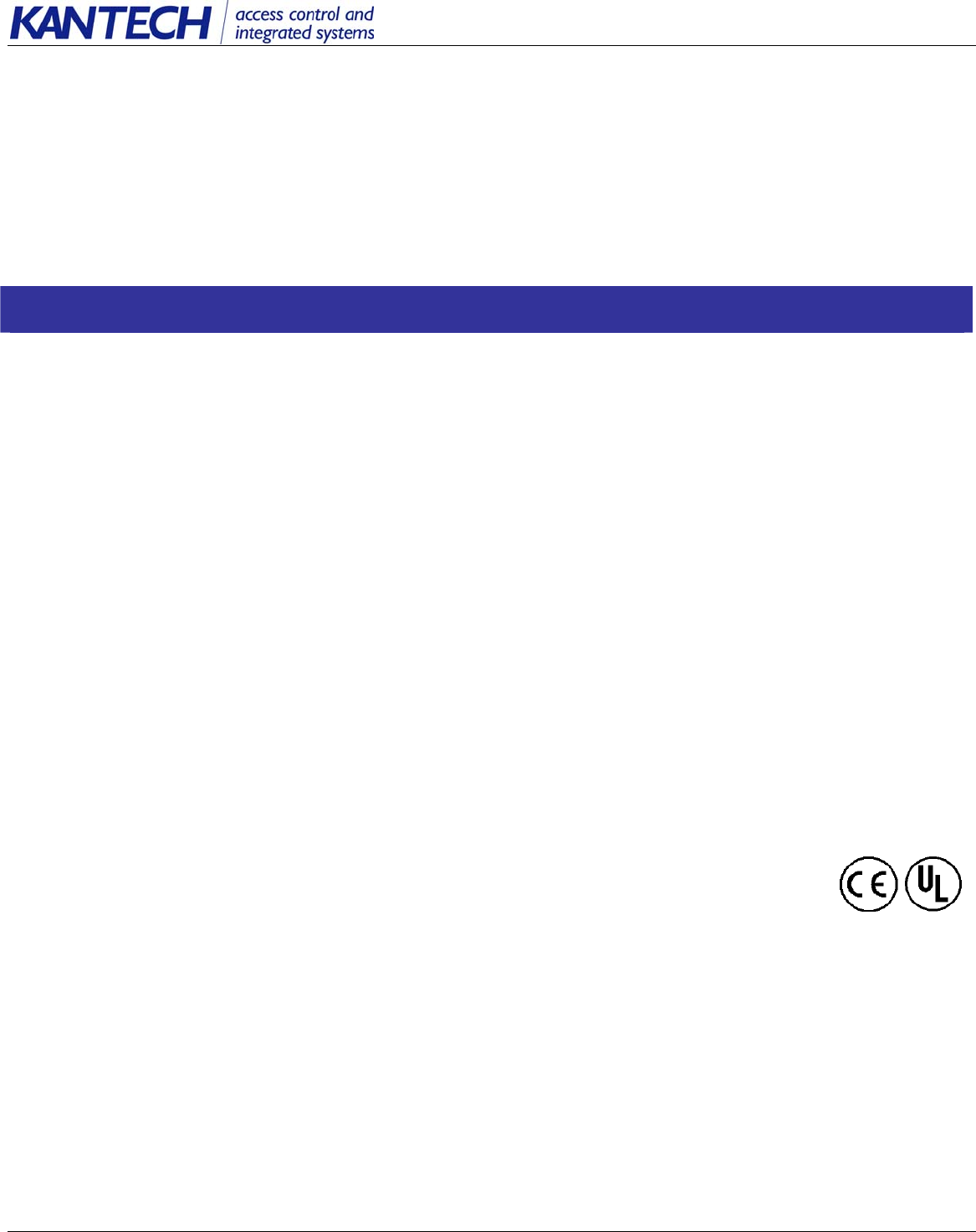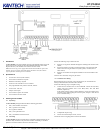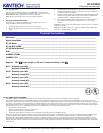
Tel.: 1 (450) 444 2030 • Toll Free: 1 888 222-1560 • Fax: 1 (450) 444 2029 • Internet: www.kantech.com DN1246-0404
Copyright 2004 Kantech Systems. All rights reserved • Specifications may change without notice.
Kantech Systems
KT-PC4204
4 Rela
y
Output and Power Suppl
y
3.4. Applying Power
After all wiring is completed, apply power to the KT-300. Connect the battery
leads to the battery, then connect the AC transformer. Then, connect power to the
KT-PC4204: the battery leads followed by the AC transformer.
Note: Do not connect the power until all wiring is complete.
4. Assigning the KT-PC4204 module
Once all wiring is complete, the module must be assigned to the system. To
assign the module, perform the following steps:
1. Establish communication between the PC and the controller,
2. Remove the tamper switch wire (or only the wire if tamper switch is not
used),
3. A serial number should be displayed on the screen, in the same window
where is the serial number appears, you should see the type of module and
on which controller it is connected,
4. From the software, select the functionality of the module and enter the serial
number in the appropriate field (see your software reference manual under
controller definition -- Assigning modules for more details),
5. If the module is used in “repower” mode, assign an “all valid” schedule to
relay 1 and assign the module’s functionality to “relay 1 to 4” in your
software.
Note: Don’t forget to reconnect the tamper switch (or the wire, if there is
no tamper switch).
Note: If the module is uses as a “repower” module, ensure that Jumper
J1 is set to “Combus Relay” position.
Terminal Connections
Module no.: ______________________________________________________________________________________
Date of installation: _______________________________________________________________________________
KT-300 Name: ____________________________________________________________________________________
KT-300 SITE NAME: _______________________________________________________________________________
KT-300 Serial Number: _____________________________________________________________________________
AUX: ___________________________________________________________________________________________
COMBUS (FROM):_________________________________________________________________________________
COMBUS (TO): ___________________________________________________________________________________
Repower: YES:
(if yes, assign an “All valid” schedule to Relay 1) NO:
RLY1: Normally open (NO): ________________________________________________________________________
Normally closed (NC): _______________________________________________________________________
RLY2: Normally open (NO): ________________________________________________________________________
Normally closed (NC): _______________________________________________________________________
RLY3: Normally open (NO): ________________________________________________________________________
Normally closed (NC): _______________________________________________________________________
RLY4: Normally open (NO): ________________________________________________________________________
Normally closed (NC): _______________________________________________________________________
FCC & IC COMPLIANCE STATEMENT
CAUTION: Changes or modifications not expressly approved by Kantech Systems Inc. could void your authority to use this equipment.
This equipment generates and uses radio frequency energy and if not installed and used properly, in strict accordance with the manufacturer’s instructions, may cause
interference to radio and television reception. It has been type tested and found to comply with the limits for Class B device in accordance with the specifications in Subpart
“B” of Part 15 of FCC Rules, which are designed to provide reasonable protection against such interference in any residential installation. However, there is no guarantee
that interference will not occur in a particular installation. If this equipment does cause interference to television or radio reception, which can be determined by turning the
equipment off and on, the user is encouraged to try to correct the interference by one or more of the following measures:
•
Re-orient the receiving antenna
•
Relocate the alarm control with respect to the receiver
•
Move the alarm control away from the receiver
•
Connect the alarm control into a different outlet so that alarm control and receiver are on different circuits.
If necessary, the user should consult the dealer or an experienced radio/television technician for additional suggestions. The user may find the following booklet prepared
by the FCC helpful: “How to Identify and Resolve Radio/Television Interference Problems”. This booklet is available from the U.S. Government Printing Office,
Washington, D.C. 20402, Stock # 004-000-00345-4. This device complies with Part 15 of the FCC rules. Operation is subject to the following two conditions: (1) this
device may not cause harmful interference, and (2) this device must accept any interference received including interference that may cause undesired operation. This class
B digital apparatus meets all requirements of the Canadian Interference Causing Equipment Regulations. The KT-300 is also compliant with EN55022: 1994, amendment 1:
1995, Class B.




